Discovering Veganism as a Farmer: A Veganic Story
Guest post by Matt Loisel, veganic gardening instructor, co-founder of Lazy Millennial Farms and creator of Murder, a graphic novel on a domesticated animal uprising. Follow him on Instagram.
Four years ago, my wife and I were just a couple of vegetarian gardeners going about our lives, knowing nothing of veganic agriculture or its role in the sustainability of our species. Two years later, we were commercial farmers who had founded the Bay Area’s first and only veganic farm and CSA program.
Four years ago, in typical millennial fashion, a long series of Netflix documentary binges set us down a path of research that convinced us we needed to start a farm for ourselves. The goal was to develop a set of practices that would be both ethical and sustainable.
While chicken tractors, heliciculture (or snail rearing), and high intensity quail egg production tempted us along our path to discovering our identity, we ultimately happened upon the Agricultural Land Based-Association (ALBA). ALBA is a small non-profit in Salinas that trains people who are passionate enough about agriculture that they want to start their own farms. Through our ten-month course we learned all of the basic, essential skills we would need to run a successful organic vegetable farming operation.

Brittany Loisel at Lazy Millennial Farms
What we learned covered a huge swath of topics, from crop planning and bookkeeping, to tillage and plant nutrition. I did my best to absorb all of the information, and the ten months quickly expired. At the end of the technical training, some students were accepted into the farm incubator program to lease land and try their hand at starting their own farms. It was around this time, right before we signed our first lease, that both my wife and myself decided to go… vegan. *crowd gasps*
Our decision was entirely based on the idea that it was the most sustainable diet we could have. However, mere moments after making our minds up to change our diets, it dawned on us that all of our agricultural training leading up to this point had relied heavily on animal byproducts for fertility. There had been no discussion or mention of alternative sources of plant nutrition, only those most readily available to us. Blood meal. Bone meal. Feather meal. Fish emulsion. Manure.
Of course, none of this had been foreign to me. My grandma, or as I call her, “Ammama,” had brought gardening with her when she and my grandfather came to America in the 1960s. It was through her that I learned how to grow plants. I showed little interest towards it in my childhood, but something awoke in me in high school that made me want to start my own garden.
My grandma and I went down to the local nursery, loaded up on compost and transplants, and I started my very first garden. My grandma was by no means an organic gardener, but to this day I continue to use many of her methods on our garden. She had her own compost bin, weeded religiously and grew a large variety of plant families, but also used conventional herbicides, pesticides and fertilizers. Of the many lessons that I would learn from Ammama, some of them would end up being what not to do.
Fast forward years later: while I studied to become a farmer, the garden that I was growing at home was entirely organic and pesticide-free but by no measure veganic. Our house was surrounded by horse ranches, so free manure was everywhere for the taking. I had never heard of veganic gardening or agriculture. Never heard an argument in its defense. I had never even heard of it as a vague concept. It wasn’t until we were on the precipice of signing our lease that I started to think about veganic agriculture.
The first step in our journey of discovery was in typical millennial fashion: through Google. Google will tell you some interesting factoids about whatever you may be interested in, but when we tried learn about more in-depth aspects to long term, large-scale veganic production, there was very little to glean.
The internet told me several things: veganic agriculture and gardening exists. People all over the world are currently practicing it. Some people use worm castings and consider it veganic, some people don’t. Some veganic farms are big, but most of them are small family farms.
Unsatisfied with what I found, I deferred to an old “Get Out Of Jail Free” card I sometimes use when I am stumped and don’t know in which direction to go: I asked someone smarter than me. During my time at ALBA, one of my favorite speakers was a scientist with the USDA named Dr. Eric Brennan. Dr. Brennan spoke on the wonders of cover cropping, and I was instantly a fanboy. Some of his most interesting studies are his 2013 study titled “Agronomic aspects of strip intercropping lettuce with alyssum for biological control of aphids.” At the time he hadn’t published the papers yet, but when I reached out to him he was working on fascinating studies, such as, “Cover crop frequency and compost effects on a legume-rye cover crop during 8 years of organic vegetables” and “Cover cropping frequency is the main driver of soil microbial changes during six years of organic vegetable production.”
My main apprehension about veganic agriculture was about the soil microbes. I had read academic books on soil microbiology and understood enough about the essential role it played in the healthy life cycle of a plant. I worried that without the addition of animal byproducts, and manure in particular, the soil would not have all of the nutrients to support the bacteria and fungi necessary for food production. I was especially worried about the bacteria. So I sent an email to Dr. Brennan and his response was more than encouraging: “I’d not worry about the microbes… they are much more resilient than we often realize, especially when we add lots of organic matter to the soil.”
I also turned to an old standby: Teaming with Microbes by Jeff Lowenfels and Wayne Lewis. I was very surprised that for all their talk of manure in the book, the authors took a positive spin on veganics: “Human and pet feces should not be composted because of the possibility that disease organisms might survive even the high heat of the compost process; for the same reason, we personally discourage the timeworn practice of using other manures in compost… Who wants to be worried about E. coli?” The book goes on to talk about the connection between tillage, manure and bacteria supporting nitrogen-loving vegetables at the expense of soil structure and the equally, if not more, important soil fungi.

Matt Loisel at Lazy Millennial Farms
So I had my answer. I had gathered enough evidence that veganic agriculture was sufficiently viable to at least be attempted. We founded Lazy Millennial Farms, which was entirely veganic from the onset. During our time there, our plants grew as well or better than those of our neighbors. We produced at a commercial level and saw no downside to farming veganically. Animals do not appear to be necessary for growing healthy soil, so to quote Dr. James McWillaims, “We’re killing animals for food that we do not need.”
My wife and I recently left Lazy Millennial Farms in the hands of a new owner, who will continue to grow veganically. I continue to promote veganics through public speaking and by teaching veganic gardening workshops.* My hope is that we can build a stronger network of information on veganics to help those that come after us. More attention needs to be given to developing practices that produce maximum health and prosperity for humanity, while still maintaining unyielding mercy on animalkind.
* Check out the Seed the Commons calendar for upcoming dates.
Photo Credits: Photos by Isabella La Rocca
Read Seed the Commons’ interview with Matt, the first in our series on veganic farmers and gardeners.
Learn more about veganic farms on Veganic World.
